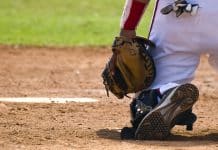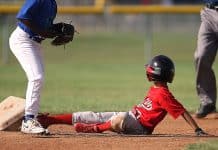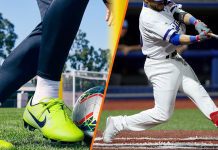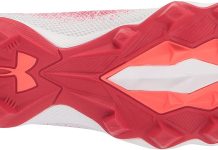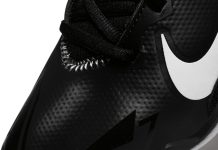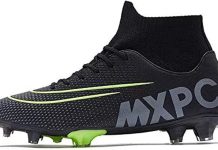Imagine stepping onto a baseball field, the fresh-cut grass under your feet, the sound of the crowd buzzing with excitement.
One question looms as you gear up for the game: What types of studs work best on a baseball field?
This article will explore the different types of studs and their effectiveness on the baseball diamond.
Whether you’re a player, coach, or simply curious, get ready to discover the secrets to optimal traction and performance on the field.
Rubber Cleats
Rubber cleats are popular for baseball players due to their versatility and traction. One of the main advantages of rubber cleats is their ability to provide excellent traction on various surfaces. Whether playing on grass, artificial turf, or natural dirt infields, rubber cleats can provide the grip you need to make quick and agile movements on the field.
Another advantage of rubber cleats is their durability. Unlike metal cleats, which can wear down or break over time, rubber cleats tend to be more resistant to wear and tear. This makes them a cost-effective option for players who want a long-lasting pair of cleats.
While rubber cleats offer many advantages, there are a few disadvantages. One of the main drawbacks is that rubber cleats do not provide as much traction on wet or muddy surfaces as metal cleats. This can make it more challenging to maintain your footing and perform at your best in adverse weather conditions.
Additionally, rubber cleats may not be suitable for players who need additional support or stability. If you have ankle or foot issues, you may find that rubber cleats do not provide enough support for your specific needs.
Rubber cleats are excellent for baseball players who want versatility, durability, and reliable traction. They are instrumental on grass, artificial turf, and dirt infields.
Metal Cleats
Metal cleats are known for their exceptional traction and stability on the baseball field. One of the main advantages of metal cleats is their ability to dig into the ground, providing excellent grip and traction. This is especially beneficial when playing on wet or muddy surfaces, as metal cleats can help you easily maintain your footing and make quick movements.
Another advantage of metal cleats is their durability. Metal cleats are typically made with high-quality materials that can withstand the wear and tear of the game. Unlike rubber, metal cleats are less likely to wear down or break over time, making them a long-lasting option for dedicated baseball players.
However, it is also essential to consider the disadvantages of metal cleats. One major drawback is that metal cleats are unsuitable for all playing surfaces. They can cause damage to artificial turf, natural dirt infields, and clay-like surfaces. Some fields may even prohibit using metal cleats to prevent damage to the playing surface.
Another disadvantage of metal cleats is their potential to cause injury. The sharp metal studs can accidentally harm other players if a collision occurs. Metal cleats can also cause injuries to the wearer, as the studs can penetrate the skin if not careful.
In summary, metal cleats offer exceptional traction and durability, making them ideal for players who prioritize stability and grip. They are best suited for wet or muddy surfaces, but it is essential to check field regulations to ensure they are allowed.
Molded Plastic Cleats
Molded plastic cleats are a versatile option for baseball players, balancing traction and comfort. One of the advantages of molded plastic cleats is their ability to provide adequate grip on various field surfaces. Whether playing on grass, artificial turf, or natural dirt infields, molded plastic cleats can offer the traction you need to perform at your best.
Another advantage of molded plastic cleats is their comfortable and lightweight nature. These cleats are typically made with softer materials than metal cleats, making them more comfortable to wear for extended periods. The lightweight nature of molded plastic cleats can also contribute to increased speed and agility on the field.
However, a few disadvantages exist when using molded plastic cleats. One drawback is that they may not offer as much traction as metal cleats, especially on wet or muddy surfaces. This can make it more challenging to maintain stability and perform quick movements in adverse weather conditions.
Molded plastic cleats may not have the same durability level as metal cleats. Over time, the studs on molded plastic cleats can wear down or break, requiring replacement sooner than other cleats.
It is overall. Molded plastic cleats suit players who want a comfortable, lightweight option that provides adequate traction on different field surfaces. They are handy for players who prioritize comfort and versatility.
Turf Shoes
Turf shoes are specially designed for playing on artificial turf surfaces. One of the main advantages of turf shoes is their ability to provide superior traction on turf. The tiny rubber studs or nubs on the sole of turf shoes help grip the artificial grass, allowing for quick movements and direction changes without slipping.
In addition to traction, turf shoes offer excellent comfort and flexibility. The design of these shoes focuses on providing cushioning and support for the feet, making them ideal for long hours of play on artificial turf.
However, there are some disadvantages to consider when wearing turf shoes. Firstly, these shoes are not ideal for other playing surfaces such as natural grass, dirt infields, or clay-like surfaces. The small studs on turf shoes are not designed to provide sufficient traction on these surfaces, and using them may increase the risk of slipping or injury.
Another disadvantage of turf shoes is their limited use in wet or muddy conditions. The shallow stud design of turf shoes may not be able to penetrate the soft ground effectively, resulting in reduced traction and stability.
In summary, turf shoes are excellent for baseball players who primarily play on artificial turf surfaces. They offer superior traction, comfort, and versatility on turf but are unsuitable for other playing surfaces or wet conditions.
Interchangeable Cleats
Interchangeable cleats provide the best of both worlds by allowing players to switch between different cleats depending on the playing conditions. This flexibility is one of the main advantages of interchangeable cleats. With an interchangeable cleat system, players can use metal studs for wet or muddy conditions to maximize traction and swap them out for rubber or molded plastic studs for dry or artificial turf surfaces.
Another advantage of interchangeable cleats is their ability to accommodate players with different preferences. Some players may prefer the stability and grip of metal cleats, while others may prioritize the comfort and versatility of rubber or plastic cleats. With interchangeable cleats, players can easily customize their footwear to suit their needs.
However, there are a few disadvantages to consider when using interchangeable cleats. One drawback is the additional cost. Interchangeable cleat systems often require multiple types of studs, which can be more expensive than purchasing a single pair of cleats.
Switching out studs may be time-consuming, especially if done frequently during a game. Players must have the appropriate tools and time to make the necessary changes.
Overall, interchangeable cleats offer excellent adaptability and customization for baseball players. They are ideal for players who frequently play on different field surfaces or prefer to switch between different types of cleats.
Turf Trainers
Turf trainers, also known as turf sneakers, are famous for baseball players who primarily play on artificial surfaces. The advantages of turf trainers are similar to turf shoes but have a more casual and sneaker-like design.
One of the main advantages of turf trainers is their superior traction on artificial turf. The rubber outsole with small studs or nubs provides exceptional grip and stability on the turf, allowing for quick movements and direction changes.
Another advantage of turf trainers is their versatility. These shoes are more casual than cleats, making them suitable for wearing off the field. This means players can wear their turf trainers to and from games without bringing extra shoes.
However, there are a few disadvantages to consider when choosing turf trainers. Firstly, these shoes may not be suitable for other playing surfaces, such as grass or natural dirt infields. The stud design on turf trainers is specifically designed for artificial turf and may not provide adequate traction on other surfaces.
Turf trainers may also not offer the same support and protection as cleats. They are generally lighter and more flexible, which can benefit speed and agility but may sacrifice some stability and ankle support.
In summary, turf trainers are comfortable and versatile for baseball players who primarily play on artificial turf surfaces. They offer superior traction and are suitable for casual wear off the field but may not provide the necessary support and traction on other playing surfaces.
Prohibited Cleats
Certain types of cleats are prohibited from use in baseball due to their potential to cause damage to the field or pose a safety risk to players. These prohibited cleats include those with metal points, longer cleats, and cleats with sharp edges.
Cleats with metal points are typically not allowed on baseball fields as the metal studs can dig into the playing surface, causing damage to grass, turf, or dirt infields. They can also pose a safety risk to other players if a collision occurs, as the metal studs can cause injury upon impact.
Longer cleats, or spike cleats, are often prohibited in baseball. These cleats have significantly longer studs than standard cleats and can cause more damage to the playing surface. The longer studs can also increase the risk of tripping or getting stuck in the ground, potentially leading to injuries.
Cleats with sharp edges are another type typically not allowed in baseball. Sharp-edged cleats can cause injury to other players if contact is made, intentionally or accidentally. They can also cause damage to the field if the sharp edges dig into the playing surface.
It is essential to adhere to the rules and regulations regarding cleat usage to maintain the integrity of the field and ensure the safety of all players involved.
Factors to Consider
When choosing the right cleats for baseball, several factors must be considered. These factors include field conditions, weather conditions, player position, and preference.
Field condition is an essential factor to consider when selecting cleats. The type of field surface, whether grass, artificial turf, natural dirt infield, or clay-like infield, can influence the type of cleat that will provide optimal traction and performance.
Weather conditions also play a significant role in determining the most suitable cleats. Wet or muddy conditions may require cleats with deeper studs or metal cleats to ensure sufficient traction. Dry conditions or artificial turf surfaces may better suit rubber or plastic cleats.
Player position is another crucial factor to consider. Different positions in baseball have varying demands and requirements. For example, pitchers may prioritize stability and grip to maximize control, while outfielders may require speed and agility to cover more ground. Ensuring that cleats meet the specific needs of a player’s position can contribute to improved performance.
Finally, player preference should also be taken into account. Some players may have personal preferences regarding the type of cleats they feel most comfortable wearing. They must consider their comfort and playing style to select the best cleats.
Baseball Field Surfaces
Baseball can be played on various field surfaces, each with unique characteristics. Understanding the different field surfaces can help determine the most suitable cleats for optimal performance.
Grass is one of the most common field surfaces in baseball. Grass fields typically provide good traction and stability, making rubber or plastic cleats suitable. These cleats can grip the grass surface without causing excessive damage.
Artificial turf fields have become increasingly popular in baseball. These fields require specific cleats designed for artificial turf surfaces. Turf shoes or trainers with small rubber studs or nubs are ideal for these fields, offering excellent traction and minimizing the risk of damage to the turf.
Natural dirt infields are another type of field surface commonly found in baseball. Rubber or plastic cleats are typically sufficient for these surfaces, providing adequate grip and minimizing damage to the dirt.
Clay or clay-like infields have unique characteristics, often requiring cleats with specific stud designs. Cleats with shorter or more widely spaced studs are joined on clay infields to prevent excessive digging or sticking to the surface. Rubber or plastic cleats with a turf stud pattern are often suitable for these fields.
Understanding the characteristics of different field surfaces can help guide the selection of cleats to provide the best traction, stability, and performance for each field type.
Tips for Choosing the Right Studs
Selecting the correct studs for your cleats is crucial for optimal performance on the baseball field. Here are some tips to help you choose the suitable studs:
- Evaluate Field Conditions: Consider the type of field surface and its condition. Determine if the field is wet, muddy, dry, or artificial turf. This will help determine the traction requirements and the type of cleats or studs that provide the best grip.
- Consider Weather and Climate: Weather conditions can significantly impact the field’s condition and affect the performance of the cleats. Wet or muddy conditions may require deeper studs for improved traction, while dry conditions or artificial turf may be better suited for shorter studs.
- Understand Player Position Requirements: Different positions in baseball have unique demands and requirements. Pitchers may benefit from cleats prioritizing stability and grip, while outfielders may require cleats prioritizing speed and agility. Consider the specific needs of the player’s position when selecting studs.
- Account for Player Preference: It is essential to consider the comfort and preferences of the player. Some players may have personal preferences for specific stud designs or materials. Taking player preference into account can contribute to better comfort and overall performance.
By carefully evaluating field conditions, weather conditions, player position requirements, and player preference, you can choose the correct studs for your cleats, ensuring optimal traction, stability, and performance on the baseball field.








